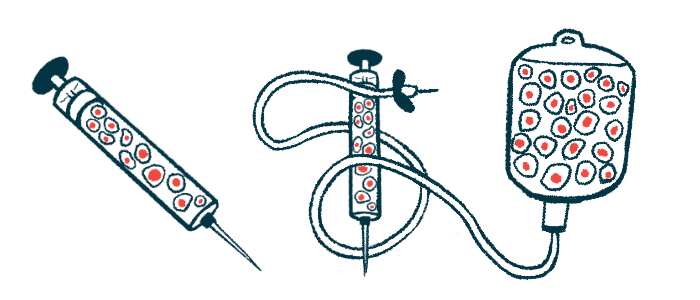New regimen boosts bone marrow transplant as ‘curative’ SCD option
Event-free survival nearing 83% seen with Phase 2 trial's conditioning regimen

A bone marrow transplant approach that doesn’t use high-dose chemotherapy to prevent an immune response against a donor’s stem cells showed high rates of event-free and overall survival among sickle cell disease (SCD) patients treated in a Phase 2 clinical trial.
The approach, which also expands the eligibility of potential donors, uses a pretransplant conditioning regimen that is not myeloablative, meaning it doesn’t kill all the stem cells in a patient’s bone marrow to make room for new ones. But it is strong enough to prevent donor stem cell rejection, particularly in adults.
Event-free survival, referring to patients alive and without graft failure, approached 83% at two years post-transplant, and two-year overall survival was 94%, researchers reported. Graft failure occurred in eight of 32 children, but was not found in the trial’s 38 adults.
“We demonstrate that non-myeloablative haploidentical BTM [bone marrow transplant] with thiotepa and PTCy [cyclophosphamide] is a readily available curative therapy for most adults, even those with organ damage,” the scientists wrote.
Its conditioning regimen also is less costly and easier to administer than “the more expensive myeloablative gene therapy and gene editing” approaches, possibly making it a treatment option for lower-income countries like those of Africa, the team added.
Trial tested new version of a less intensive conditioning regimen
The study, “An International Learning Collaborative Phase 2 Trial for Haploidentical Bone Marrow Transplant in Sickle Cell Disease,” was published by an international group of researchers in the journal Blood.
SCD is a genetic disease where red blood cells take on a sickle-like shape. This change is caused by the presence of a faulty form of hemoglobin, the protein in red blood cells that transports oxygen throughout the body, and disease symptoms can be life threatening.
An allogeneic stem cell transplant uses donor stem cells to replace a patient’s blood-forming stem cells in the bone marrow. The transplanted cells then start to make new, healthy red blood cells.
Allogeneic stem cell transplants offer a cure for SCD, but their use can be limited by difficulties in finding matched donors and the aggressiveness of myeloablative conditioning regimens. These regimens help to prevent the patient’s body from rejecting the transplanted stem cells, but they can be too intense for some, resulting in serious complications or death.
“To reduce transplant-related toxicity and mortality, particularly for adults with SCD, non-myeloablative or reduced intensity conditioning regimens have been developed,” the researchers wrote, noting that a major limitation of one such regimen was graft failure rate of 40%.
Scientists, led by a team at Vanderbilt University in Nashville, conducted a Phase 2 study (NCT01850108) to assess an alternative conditioning regimen and stem cells from haploidentical donors, a less strict matching system that by definition includes a patient’s family. The alternative regimen consisted of adding the chemotherapy agent thiotepa to the previously tested reduced-intensity regimen — fludarabine, cyclophosphamide, antithymocyte globulin, and low-dose total body irradiation — given to prepare SCD patients for a transplant.
Patients after the transplant again were given cyclophosphamide to prevent graft-versus-host disease, which can occur when the transplanted stem cells (the graft) attack the patient’s body (the host).
Stem cell donors were family members for all 70 study patients
The study enrolled 70 children and adults with a diagnosis of SCD, with patients recruited at sites in North America, Europe, and Asia. The group’s median age was 19.1, and most (95.6%) received a transplant from a parent or sibling. Graft failure occurred in eight patients (11.4%), all younger than 18 years old.
“None of the adults … were excluded from the trial because of stroke or severe pre-existing heart, lung, and kidney disease,” the scientists noted.
Researchers expected at least 80% of the patients would survive without their graft being rejected within two years of the transplant. The study’s actual event-free survival rate was 82.6% at two years, and its overall two-year survival rate was 94.1%, “with no difference between children and adults,” the researchers wrote.
Most patients had successful engraftment, meaning the transplanted stem cells survived and expanded within the bone marrow. Of the 59 people with full engraftment, 57 (96.6%) stopped using immunosuppressive medications one year after the transplant.
Complications included severe or very severe acute graft-versus-host disease in about 10% of patients at one year post-transplant, and again with no difference between children and adults (12.5% and 7.9%). About the same proportion had moderate or severe chronic graft-versus-host disease at two years of follow-up. Five patients (7.1%) died due to infections.
“To our knowledge, we completed the first multicenter, international phase 2 trial of a non-myeloablative haploidentical BTM with thiotepa and PTCy to cure children and adults with SCD,” the researchers wrote, adding that they consider this approach “readily available” for SCD patients in middle- and high-income countries and of “emerging” availability in Africa, “where at least 70% of the world’s children with SCD are born.”
This type of a bone marrow transplant and its conditioning regimen “is now a therapeutic curative option for adults with SCD in middle-high income BMT centers,” the researchers concluded.
For children, however, “additional modifications in the conditioning regimens are required to decrease graft failure that is not associated with death,” they added.







